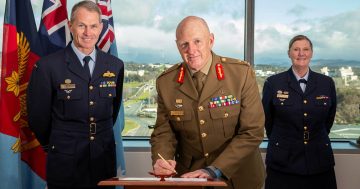
Defence Industry Pat Conroy (front) launches the Strategy with (L-R) Deputy Secretary of CASG Chris Deeble, Vice-Chief of Defence Force VADM David Johnson, Head of DSTG Professor Tanya Monro, and GWEO Chief AIRMSHL Leon Phillips. Photo: ADF.
The Federal Government has released a new strategy it says will maximise the nation’s sovereign defence industrial base as it expands the Australian Defence Force to prepare for future threats.
The Defence Industry Development Strategy (DIDS) explains what defence industrial base capabilities will be needed in the face of the changing strategic circumstances outlined in the 2023 Defence Strategic Review (DSR). The strategy outlines the actions the government will take to grow that industrial base and deliver a greater partnership between Defence and industry.
The DSR highlighted the vision for Defence to transition to a more integrated and focussed force, and recognised that defence industry was essential to delivering that vision.
Minister for Defence Industry Pat Conroy says in the strategy’s foreword: “The Defence Industry Development Strategy directly supports the delivery of the Defence Strategic Review, and underpins the forthcoming National Defence Strategy. It articulates the need for a sovereign defence industrial base and takes a holistic approach to its definition.”
The strategy provides policy settings to align with that vision, including Sovereign Defence Industrial Priorities (SDIP) supported by detailed information on areas of priority, and reforms to procurement processes.
It also lays the groundwork for growing and developing the workforce required to deliver capability, uplifting the security posture of defence industry, and a new approach to innovation.
It also aims to change the way Defence engages with industry – to better inform industry of Defence’s needs and Defence of industry’s capabilities.
The seven SDIPs are:
- Maintenance, repair, overhaul and upgrade of ADF aircraft.
- Continuous naval shipbuilding and sustainment.
- Sustainment and enhancement of the combined arms land system.
- Domestic manufacture of guided weapons, explosive ordnance and munitions.
- Development and integration of autonomous systems.
- Integration and enhancement of battlespace awareness and management systems.
- Test and evaluation, certification and systems assurance.
Other policies in the strategy include a streamlining of Defence’s procurement framework without compromising on governance. The strategy says the proposed reforms will make it easier, faster and more efficient for industry to work with Defence.
Defence will also look to establish more long-term strategic partnerships with industry to deliver capabilities by supporting their innovation, design, development and production cycle.
“It highlights the need to pursue closer industrial collaboration and integration with our trusted partners. This includes co-development, co-production and co-sustainment opportunities,” according to the strategy’s foreword.
The strategy will also aim to develop defence exports by backing Australian industry and increasing opportunities with trusted international partners through government-to-government arrangements.
Launching the strategy at Canberra’s CEA Technologies, Minister Conroy said Australia’s defence industry supported more than 100,000 Australian jobs.
“It is an essential partner in keeping Australians safe at home, secure in the world and employed in well-paid, high skill jobs,” he said.
“This strategy will underpin essential reforms that will ensure that critical capabilities are provided to the men and women of the ADF as soon as possible, while also supporting an industry vital to our national security.
“I look forward to working with industry to implement the Defence Industry Development Strategy, and deliver an innovative, resilient and competitive Australian defence industrial base that creates a stronger, more secure Australia.”
The new Defence Industry Development Strategy and a number of fact sheets are available here.





















